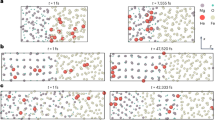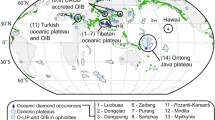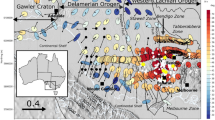Abstract
Merrihue1 first observed helium with a very high 3He/4He isotope ratio ( ≥10−4; here termed exotic helium) in a magnetic separate of a deep-ocean sediment and attributed it to input of extraterrestrial material. Krylov et al.2 subsequently reported the existence of exotic He in several deep-sea sediments, while Tilles3 measured argon isotope ratios in magnetic separates of two ocean sediments. Observing that the 3He/4He ratio is inversely correlated with the sedimentation rate, Ozima et al.4 concluded that the exotic He is carried by interplanetary dust particles (IDPs). We have now examined other deep-sea sediments to characterize the exotic He and to identify its carrier, and have confirmed that the exotic He resides mainly in a strongly magnetic fraction. Stepwise degassing experiments suggest that the exotic He consists of a single component. The carrier of the He is likely to be chondritic IDPs. The higher level of exotic He in magnetic fractions of sediments can be explained by secondarily produced magnetite in IDPs as a result of thermal shock during atmospheric entry.
This is a preview of subscription content, access via your institution
Access options
Subscribe to this journal
Receive 51 print issues and online access
$199.00 per year
only $3.90 per issue
Buy this article
- Purchase on Springer Link
- Instant access to full article PDF
Prices may be subject to local taxes which are calculated during checkout
Similar content being viewed by others
References
Merrihue, C. Ann. N.Y. Acad. Sci. 119, 351–367 (1964).
Krylov, A. Ya., Mamyrin, B. A., Silin, Yu. I. & Khabarin, L. V. Geochem. Int. 10, 202–205 (1973).
Tilles, D. Science 153, 981–984 (1966).
Ozima, M., Takayanagi, M., Zashu, S. & Amari, S. Nature 311, 448–450 (1984).
Kobayashi, K., Tonouchi, S., Furuta, T. & Watanabe, M. Bull. Ocean Res. Inst. 13, 116–121 (1980).
Mizuno, A. et al. in Cruise Rep. 15 (ed. Mizuno, A.) 1–31 (Geological Survey of Japan, Tsukuba, 1981).
Mizuno, A. et al. in Cruise Rep. 18 (eds Mizuno, A. & Nakao, S.) 1–35 (Geological Survey of Japan, Tsukuba, 1982).
Ozima, M. & Podosek, F. A. Noble Gas Geochemistry, 68–126 (Cambridge University Press, 1983).
Løvlie, R. Earth planet. Sci. Lett. 21, 315–320 (1974).
Rajan, R. S. et al. Nature 267, 133–134 (1977).
Fraundorf, P. & Shirk, J. Proc. 10th lunar planet. Sci. Conf. 951–976 (1979).
Fraundorf, P. Geochim. cosmochim. Acta. 45, 915–943 (1981).
Brownlee, D. E., Olszewski, E. & Wheelock, M. Lunar planet Sci. 13, 71–72 (1982).
Hyman, M., Rowe, M. W. & Herndon, J. M. Geochem. J. 13, 37–39 (1979).
Fraundorf, P., Brownlee, D. E. & Walker, R. M. in Comets (ed. Wilkening, L. L.) 383–409 (University of Arizona Press, 1982).
Brownlee, D. E. Rev. Geophys. Space Phys. 17, 1735–1743 (1979).
Fraundorf, P. Geophys. Res. Lett. 10, 765–768 (1980).
Brownlee, D. E., Tomandl, D. A. & Olszewski, E. Proc. 8th lunar Sci. Conf. 149–160 (1977).
Brownlee, D. E. Ann. Rev. Earth planet. Sci. 13, 147–173 (1985).
Brownlee, D. E. in Protostars and Planets (ed. Gehreis, T.) 134–150 (University of Arizona Press, 1978).
Author information
Authors and Affiliations
Rights and permissions
About this article
Cite this article
Amari, S., Ozima, M. Search for the origin of exotic helium in deep-sea sediments. Nature 317, 520–522 (1985). https://doi.org/10.1038/317520a0
Received:
Accepted:
Published:
Issue Date:
DOI: https://doi.org/10.1038/317520a0
This article is cited by
-
Enhanced flux of extraterrestrial 3He across the Permian–Triassic boundary
Progress in Earth and Planetary Science (2019)
-
He, Ne and Ar isotopic composition of Fe-Mn crusts from the western and central Pacific Ocean and implications for their genesis
Science in China Series D: Earth Sciences (2007)
-
Helium isotope investigation on magnetic reversal boundaries of loess-paleosol sequence at Luochuan, central Chinese Loess Plateau
Chinese Science Bulletin (2007)
-
Subduction of solar-type noble gases from extraterrestrial dust: constraints from high-pressure low-temperature metamorphic deep-sea sediments
Contributions to Mineralogy and Petrology (2005)
-
Extraterrestrial3 He in marine polymetallic nodules: A potential method for measuring growth rate of nodules
Science in China Series B: Chemistry (2002)
Comments
By submitting a comment you agree to abide by our Terms and Community Guidelines. If you find something abusive or that does not comply with our terms or guidelines please flag it as inappropriate.



